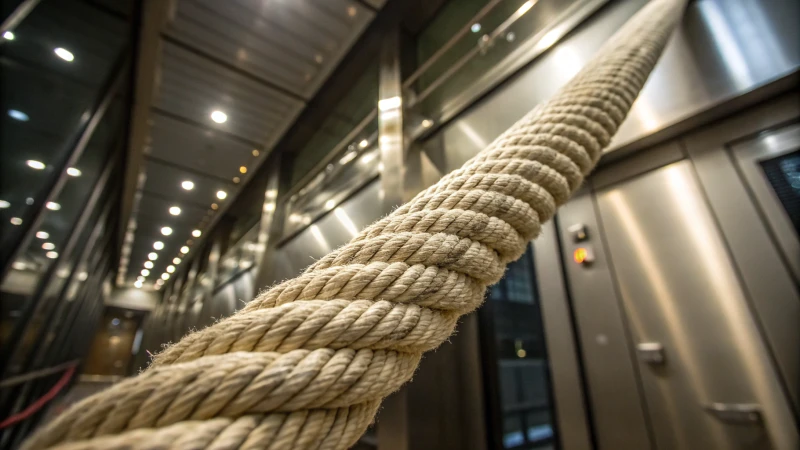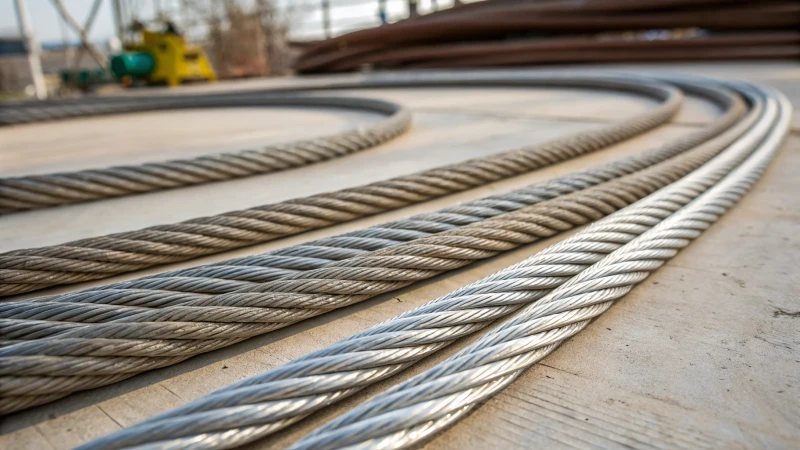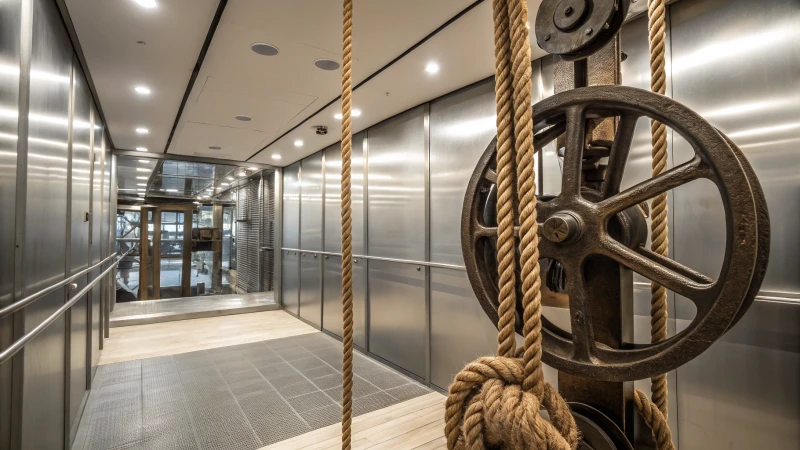
Every elevator ride depends on more than just pressing a button.
Rope diameter is crucial for elevator safety as it determines load capacity and durability. Larger diameters improve strength and lifespan but might reduce flexibility, affecting high-speed functionality.
When I first learned about elevators, I never imagined how vital those cables are to our safety. It's fascinating—and a bit intimidating—to realize how rope diameter can influence so many aspects of performance, from load distribution to fatigue resistance. Larger ropes certainly bolster strength and longevity, but they also pose challenges in maintaining the nimbleness required for swift, smooth operations. By exploring these nuances, we can better appreciate the complexity behind ensuring our rides are not only reliable but also safe.
Larger rope diameters increase elevator load capacity.True
Larger diameters enhance strength, allowing elevators to carry heavier loads.
Smaller rope diameters improve elevator flexibility.True
Smaller ropes are more flexible, aiding in high-speed operations and maneuverability.
How Does Rope Diameter Affect Load Capacity?
Ever wondered why some ropes can haul loads like champs while others snap under pressure?
The diameter of a rope is crucial for its load capacity. Larger diameters typically support higher loads because they offer more material to bear the stress. However, while they boost strength, bigger ropes can be less flexible, which might limit their usability in certain scenarios.

Diving into the World of Rope Strength
I remember my first major construction project where I had to choose the right rope for lifting heavy machinery. It was a real eye-opener to learn that the diameter of a rope isn't just a trivial detail—it determines the load capacity in a big way. Larger diameters mean more material, which translates into greater strength and durability.
The Science Behind Rope Strength
Think about it: a thicker rope has a larger cross-sectional area, making it more capable of handling stress without breaking. This is crucial when dealing with heavy-duty applications1. On the site, I learned to appreciate how critical these choices are to ensure safety and efficiency.
| Rope Diameter | Common Application | Advantages |
|---|---|---|
| 8-10 mm | Light rigging | Flexible |
| 12-16 mm | Construction lifts | Strong |
| 20 mm+ | Heavy machinery | Maximum load |
Balancing Act: Strength vs. Flexibility
As much as I loved using thicker ropes for their sheer strength, I quickly realized there was a trade-off. Larger diameters can reduce flexibility—a factor I couldn't ignore when working with dynamic systems like elevators or cranes where smooth operation is essential.
In industries like construction and mining, it's vital to match the rope to specific load requirements and environmental conditions. For instance, during my stint in mining operations2, I saw firsthand how thicker ropes were preferred for their durability under harsh conditions.
Extending Lifespan with Fatigue Resistance
I also discovered from ISO 4344 fatigue testing that ropes over 12 mm can significantly extend their lifespan, sometimes by up to 30%. But even this comes with a caveat: careful design is necessary to balance the diameter with system requirements.
Understanding these dynamics helps me make informed choices, ensuring not just meeting load demands but enhancing longevity and safety. To delve deeper into selecting the right rope diameters, check out technical guides3 online.
Larger rope diameters increase load capacity.True
More material supports the load, enhancing tensile strength.
Thicker ropes are always more flexible.False
Increased diameter reduces flexibility, affecting dynamic systems.
How Does Rope Diameter Influence Fatigue Resistance?
Ever wondered how something as simple as rope diameter could be a game-changer in your industry?
Rope diameter plays a crucial role in fatigue resistance. Larger diameters, typically over 12 mm, distribute stress more evenly, extending lifespan by 20%-30%. However, while they enhance strength, they may reduce flexibility, vital for smooth operation in high-speed systems.

The Mechanics of Fatigue Resistance
I remember the first time I had to choose a rope for a major project; it felt like picking the right teammate for a long marathon. Just like with teammates, each rope brings its unique strengths to the table. The relationship between diameter and fatigue resistance4 is like an unspoken promise of endurance and reliability. Larger diameters can handle stress more gracefully by spreading it across the entire cross-section, which reduces strain on individual strands. This means fewer breakdowns and longer life spans.
A table illustrating typical fatigue resistance improvements based on rope diameter:
| Rope Diameter | Estimated Lifespan Increase |
|---|---|
| 10 mm | 10%-15% |
| 12 mm | 20%-30% |
| 16 mm | 30%-40% |
Balancing Load Capacity and Flexibility
In my experience, balancing the rope's strength with its flexibility is akin to finding the perfect work-life balance. Larger diameters offer amazing load capacity5 but can be like that one friend who's all work and no play—less flexible. This can lead to hiccups in high-speed operations, where every bend and twist counts for seamless performance.
Practical Considerations in Rope Selection
When I’m selecting ropes for heavy-duty jobs, like in construction or mining, it feels like picking the right tool out of a cluttered toolbox. It's all about knowing what you need—load capacity versus flexibility—and finding that sweet spot that meets operational demands without compromising on fatigue resistance.
One pro tip? Pay attention to design factors like sheave size. Larger sheaves can work wonders by reducing bending stress and helping maintain flexibility, a bit like stretching before a run. Check out more insights through sheave size considerations6.
Industry-Specific Requirements
Different jobs have different needs. For instance, in mining, where ropes face tough conditions daily, durability is non-negotiable. I often think of procurement managers like John or Emma from the mining sector—they're always on the lookout for ropes that can handle harsh conditions with ease. Meanwhile, in construction, professionals like Klaus or James might prioritize flexibility to manage dynamic loads.
Conclusion
Understanding how rope diameter influences fatigue resistance isn't just about numbers; it's about ensuring safety and efficiency in our everyday operations. Armed with this knowledge, I feel better equipped to make informed choices for a variety of industrial applications. For those keen to dig deeper into this topic, check out steel wire rope innovations7.
Larger rope diameters improve fatigue resistance.True
Larger diameters distribute stress more evenly, enhancing fatigue resistance.
Increased rope diameter always improves flexibility.False
Larger diameters reduce flexibility, affecting smooth operation in some systems.
How Do Larger Rope Diameters Influence Elevator Flexibility?
Imagine you're riding an elevator, feeling the gentle hum as it glides smoothly upward. But did you know that the diameter of the elevator ropes is crucial to this smooth experience?
Yes, larger rope diameters can indeed affect elevator flexibility. While they boost load capacity and durability, they may decrease flexibility, impacting the smoothness of operation, particularly in high-speed elevators.

Understanding Rope Diameter Impacts
I remember when I first learned about the intricacies of elevator design—it was eye-opening. Larger rope diameters, typically between 12 mm to 16 mm, are chosen for their superior load-bearing capacity and fatigue resistance. I once worked on a project where we used 16 mm ropes in a high-load elevator system8. These ropes distributed forces evenly across the system, which was crucial for its stability.
| Rope Diameter | Load Capacity | Flexibility Impact |
|---|---|---|
| 12 mm | High | Moderate |
| 14 mm | Very High | Reduced |
| 16 mm | Extremely High | Significantly Reduced |
Balancing Strength and Flexibility
Finding the right balance between strength and flexibility is like walking a tightrope. On one of my projects, we opted for robust 16 mm ropes for their longevity. However, the rigidity led to a less fluid motion—like being in a car with stiff suspension. In high-speed elevators, where a smooth ride is vital, this rigidity can be a real issue. According to ISO 4344 standards, while larger ropes can extend lifespan by up to 30%, they may also compromise flexibility.
I recall a scenario where a construction site faced jerky elevator movements due to this very trade-off. We had to evaluate the trade-offs9 meticulously, weighing durability against flexibility.
Design Considerations for Optimal Performance
Designing an elevator system is about more than just choosing parts—it's about creating harmony. For elevators tasked with heavy lifting, slightly smaller diameters might offer better flexibility without sacrificing too much capacity. It's always wise to consult experts10 and run simulations. Each system has unique needs, so customizing solutions is key. After all, in my experience, one size rarely fits all when it comes to elevator design.
Larger rope diameters improve elevator flexibility.False
Larger diameters enhance strength but reduce flexibility, impacting smoothness.
Elevators with 16 mm ropes may experience jerky movements.True
The rigidity of larger ropes can lead to reduced flexibility, causing jerky rides.
Why is balancing rope diameter and system requirements crucial?
Ever wondered how the diameter of a rope can make or break your project's success? Dive into the intricate dance between rope size and system demands, ensuring safety and efficiency every step of the way.
Balancing rope diameter with system requirements is vital for safety and efficiency. Larger diameters increase load capacity but reduce flexibility, affecting system performance. A well-balanced choice enhances both lifespan and operational effectiveness.

Understanding the Dynamics of Rope Diameter
I remember the first time I had to choose a rope for a big project; it felt like picking the right tool from a toolbox where each tool had its quirks. Imagine selecting a rope for industrial use, where diameter11 isn't just a number—it's a deciding factor for safety and performance. Larger diameters typically mean greater strength and fatigue resistance, ideal for high-load situations. Think about those massive elevator systems12 where ropes between 12 mm and 16 mm work like unsung heroes, spreading forces evenly across the structure.
| Diameter Range | Common Application | Advantages |
|---|---|---|
| 8 mm - 10 mm | Light rigging and hoisting | Flexibility and cost |
| 12 mm - 16 mm | High-load elevators | Load capacity, lifespan |
| 18 mm and above | Heavy machinery and cranes | Maximum strength |
But here's the catch: as diameter increases, flexibility often takes a hit. It's something I learned the hard way when trying to ensure smooth operations in high-speed systems where every move counts.
Balancing System Requirements
Just like fitting a square peg into a round hole doesn't work, neither does ignoring system requirements13 when choosing a rope. Each application comes with its unique challenges, from weight limits to environmental factors. Picture this: mining operations demanding ropes that can brave extreme conditions without breaking a sweat.
Consider these factors:
- Load Capacity: Bigger diameters bear heavier loads, but can your system handle the trade-off in flexibility?
- Environmental Conditions: Harsh elements like saltwater or extreme temperatures require ropes with special coatings.
- Operational Speed: Fast-moving systems need ropes that marry strength with flexibility to avoid hiccups.
The Impact of Rope Selection on Safety
Safety isn't just a buzzword; it's the bedrock of any rope selection process. When you strike the right balance between diameter and system requirements, you meet safety standards and minimize risks of failure. Take it from ISO 4344: Larger diameters can extend a rope's lifespan by up to 30% if matched wisely with your system’s capabilities.
Sticking to relevant standards isn't optional—it's essential. Ensuring compliance with local and international regulations helps stave off risks tied to overloading14 or operational mishaps.
In wrapping up, balancing rope diameter with system demands might seem straightforward, but it’s an intricate art that requires a close look at multiple factors to make sure performance and safety are optimized across all applications. The right choice isn't just about numbers; it's about knowing your project like the back of your hand.
Larger rope diameters reduce system flexibility.True
Increasing diameter enhances strength but decreases flexibility, affecting performance.
All ropes with larger diameters are suitable for any environment.False
Different environments require specific coatings or materials for durability.
Conclusion
Rope diameter significantly impacts elevator safety, influencing load capacity and flexibility. Larger diameters enhance strength but may reduce flexibility, affecting smooth operation in high-speed systems.
-
Explore this link to understand how different industries use ropes of varying diameters for specific heavy-duty tasks. ↩
-
Discover why thicker ropes are favored in mining operations, focusing on their durability in challenging conditions. ↩
-
Find comprehensive guides on choosing the right rope diameter for your specific application needs. ↩
-
This link provides an in-depth look at how rope diameter impacts stress distribution and fatigue resistance, crucial for understanding durability. ↩
-
Learn how larger rope diameters increase load capacity but may affect flexibility, a key consideration in selecting the right rope. ↩
-
Explore how sheave size affects rope flexibility and operational efficiency, especially relevant in high-speed systems. ↩
-
Discover recent advancements in steel wire rope technology that enhance fatigue resistance and performance. ↩
-
Explore comprehensive specifications to understand the implications of different rope diameters on elevator systems. ↩
-
Learn about balancing durability with flexibility in elevator systems to ensure smooth operation. ↩
-
Find expert advice on optimizing elevator systems by balancing strength and flexibility. ↩
-
Understanding rope diameter helps determine its strength and flexibility, essential for selecting the right rope for your application. ↩
-
Learn about ideal rope diameters for elevator systems to ensure safety and efficiency. ↩
-
Find out how to evaluate your system's needs to choose the appropriate rope. ↩
-
Avoid potential hazards by understanding the consequences of overloading ropes. ↩

